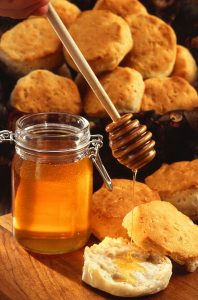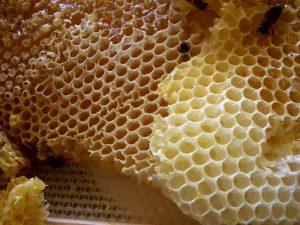 As I sit in my garden writing this blog, huge bumblebees crawling all over the tiny flowers of our Motherwort, I’m reminded just how amazing bees are. As with all insects, the different species and subspecies of bees have always intrigued me, and I love seeing them at different times throughout the season. Although not native to North America, honey bees have become a staple in American agriculture, and the honey they produce even more so. Honey, which is actually considered a specialty crop in America (along with nuts, fruit, vegetables, herbs, and cut flowers), is one of the most fascinating agricultural products. Just the numbers alone are fascinating. I couldn’t possibly recount everything I read while researching Honey and bees for this blog that I found fascinating. To be perfectly frank, I did fall down a bit of a Wiki-hole with this topic and ended up reading all about different kinds of bees.
As I sit in my garden writing this blog, huge bumblebees crawling all over the tiny flowers of our Motherwort, I’m reminded just how amazing bees are. As with all insects, the different species and subspecies of bees have always intrigued me, and I love seeing them at different times throughout the season. Although not native to North America, honey bees have become a staple in American agriculture, and the honey they produce even more so. Honey, which is actually considered a specialty crop in America (along with nuts, fruit, vegetables, herbs, and cut flowers), is one of the most fascinating agricultural products. Just the numbers alone are fascinating. I couldn’t possibly recount everything I read while researching Honey and bees for this blog that I found fascinating. To be perfectly frank, I did fall down a bit of a Wiki-hole with this topic and ended up reading all about different kinds of bees.
 Did you know…
Did you know…
Local honey is the most ethical sweetener because it has the lowest impact on the environment compared to other sweeteners. A single worker bee makes only about 1/12 teaspoon of honey in its entire lifetime. To produce just one pound of honey, foraging bees must visit approximately two million blooms. Most microorganisms don’t grow in honey, so a sealed container of honey can last for a very long time, probably hundreds of years even.
The Role of Bees and Honey
Honey bees store up honey as a cache for colder months. Bees, under the right conditions, will produce far more honey than is needed for winter. This allows a beekeeper to harvest the excess. Bees store honey in wax honeycombs. In the case of domesticated beehives, these honeycombs are on removable frames so that honey can be harvested without damaging or destroying the colony. The real importance of honey bees is their service to ecology. Honey bees are the invaluable pollinator “workhorse” of fruit and vegetable agriculture and make possible one in three bites of food we consume by pollinating the flowers of the plants that grow our food.
 Uses
Uses
Condiment: by itself, you can put honey on bread, toast, biscuits, bagels, pancakes/waffles, or in yogurt and granola. You can even dig slices of apple in it. You can also use it to sweeten a smoothie, coffee, or tea.
Salad Dressings: honey and Dijon Mustard are two of the most common emulsifiers used in salad dressings. Emulsifiers prevent the oil and vinegar from separating when blended together. Blend honey into salad dressings to provide sweetness and complement the vinegar or citrus base while also helping to ensure that your dressing holds up.
Cough Suppressant: use it to soothe a sore throat or help alleviate a persistent cough. In one study, honey was proven to be as effective as common, over-the-counter cough suppressants.
Sugar Substitute: honey is sweeter than sugar, therefore it requires less to achieve the desired sweetness, though not all honey is the same and sweetness will vary. Use ½ to ¾ cup of honey to replace 1 cup of sugar. If baking, add ¼ tsp of baking soda for each cup of sugar replaced to keep the dough from being too wet. Honey will make your baked goods more moist and dense. Lower your oven temperature by 25°F to prevent browning.
Storage
Raw honey (unheated, unfiltered) tends to crystallize sooner than commercially-processed honey. To slow crystallization, store your honey at room temperature. Crystallized honey is delicious to eat, but is prone to ferment if not consumed quickly. Re-liquify your honey by gently warming the container in a hot water bath over low heat (do not boil water).


